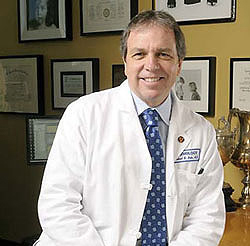June 17, 2008 - By Tracie White

Michael Dake is known for his work in image-guided treatments for arterial disease and venous disease.
Using every weapon available, from surgery to less-invasive treatments, is the key to winning the battle against heart and vascular disease, said Michael Dake, MD. A pioneer in the development of endovascular treatments for aortic pathologies, Dake will return to Stanford in July as professor of cardiothoracic surgery.
'There's power in working as an army in this fight,' said Dake, who has chaired the department of radiology at the University of Virginia for the past three years. Dake has also gained international recognition for his development of stent-grafting techniques. He will be directing the Catheterization and Angiography Laboratory at Stanford University Medical Center.
Dake will lead a program in the endovascular treatment of aortic and vascular disease, said Robert Robbins, MD, professor and chair of cardiothoracic surgery and director of the Stanford Cardiovascular Institute. 'His return will facilitate our return as an international leader in this field,' Robbins said.
Dake first came to Stanford in 1990 as section chief of cardiovascular and interventional radiology and co-director of the Catheterization and Angiography Lab. During his 15 years at Stanford, his research primarily focused on endovascular device development and management of aortic pathologies. He is known for his work in the image-guided treatments for arterial disease (hardening of the arteries) and venous disease, which occurs when veins become blocked.
Dake said he sees medical care for patients with cardiovascular diseases as becoming increasingly individualized in the future, with growing emphasis on earlier intervention and earlier diagnosis. More than ever, the team approach is key to providing optimal care, he said.
'There are continually newer and different ways to treat patients,' said Dake, who has received 20 U.S. patents over the span of his career. 'I believe in a multidisciplinary collaboration for each patient that offers a continuum of care from open surgery to endovascular surgery with opportunities for hybrids of the various treatment options at each step along the way.'
What is right for one patient may be wrong for another, based on individual characteristics such as age or anatomy, even if the diagnosis is the same.
'At the end of the day, of course, there are a number of diseases for which the traditional surgical approach is still the most durable, long-lasting approach. But for other people, particularly older people, they may not be able to tolerate surgery, and some of the newer therapies may be the best option.'
A graduate of Harvard University, Dake earned his medical degree from Baylor College of Medicine. He received his residency training in internal medicine at Baylor College of Medicine and in pulmonary medicine at UC-San Francisco. He completed a radiology residency and fellowship training in interventional radiology at UCSF.
'There's always going to be more power in ensemble,' Dake said. He added, 'If we can draw all of the specialties together we can be a leading force in this battle.'
About Stanford Medicine
Stanford Medicine is an integrated academic health system comprising the Stanford School of Medicine and adult and pediatric health care delivery systems. Together, they harness the full potential of biomedicine through collaborative research, education and clinical care for patients. For more information, please visit med.stanford.edu.